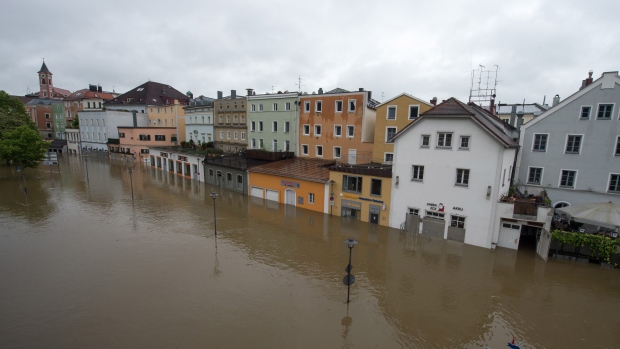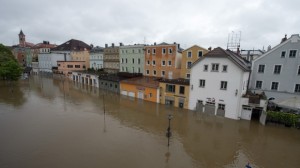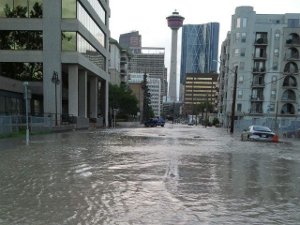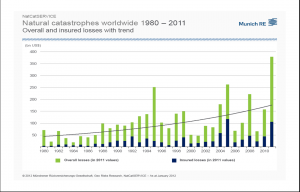December 1, 2013 – An article in the December 2013 Globe and Mail Report on Business talks about recurring floods in the German city of Passau located on the banks of the Danube River. This city is prone to flooding because it is at the confluence of three rivers. With 50,000 residents, many with distant memories of a flood that struck in 1954 when the Danube crested 12.2 meters (40 feet) above normal, you would think the city had developed a comprehensive flood plan. But last June the city was inundated by rain for several days and soon the Danube overflowed its embankments eventually rising 12.8 meters (42 feet).
Munich Re, the German reinsurer stated that the Passau flood damage amounted to 12 billion Euros of which insurance covered 3 billion. Munich Re made payouts of 83 million Euros to meet insurance claims against it and noted that the amount was twice what it had to payout when floods struck Passau in 2002.
Over on this side of the Atlantic, Calgary, Alberta, a city of over 1 million in population also was inundated by a June flood, the worst in its history. Final tallies on insurance claims have not yet been totaled but damages were estimated at $6 billion (CDN) with insured damages amounting to $1.7 billion.
The reinsurance industry has been totaling up the damages of weather events and tracking the trends and these two floods are more evidence of what has become abundantly clear to them, that anthropogenic climate change is contributing to these payouts in a big way.
Leading the pack with this opinion are Munich Re, Swiss Re, Lloyd’s of London and a Canadian insurer, The Co-operators Group. Peter Hoppe who heads up geo-risk research at Munich Re was recently quoted stating, “I’m quite convinced that most climate change is caused by human activity.” Hoppe has doctorates in meteorology and human biology. He serves as an advisor to the Max Planck Institute for Meteorology and is considered one of the world’s leading authorities on climate change. Munich Re has tracked 33,000 climate related events in its database in reaching the conclusions stated by Hoppe.
The Co-operators has calculated that natural disasters have been doubling every 5 to 7 years for the last half century. The Alberta flood contributed to the company’s reported $5.9 million second quarter loss this year with payouts on policies amounting to $77 million.
Gordon McBean, Co-director of the Centre for Environment and Sustainability, University of Western Ontario, recently remarked that the reinsurers have “raised the awareness of climate change for governments.” I wish the light bulbs within the halls of government lit up sooner because if the reinsurers have been flicking the on switch nobody seems to have noticed and when you consider the latest climate change meeting in Warsaw, governments continue to crawl towards implementing policies to drastically curtail CO2 and other greenhouse gas emissions.
Munich Re has had climatologists on board since 1974. They have been collecting data longer than any other reinsurer. They have been doing this because it impacts their bottom line. When they began they didn’t know whether human activity was the cause of climate change. They only knew that they were witnessing a very suspicious trend in all the accumulated data.
What Munich Re can show us is compelling evidence (see chart below) of rising insured and uninsured losses from natural disasters going back to 1980. And data from 1995 to 2012 shows 8 years with total losses exceeding $150 billion (U.S.) and 4 years exceeding $200 billion. Of course not all these losses are related to climate change. The Fukushima disaster was brought on by an earthquake and subsequent tsunami leading to over $400 billion in total losses in 2011. And the company also acknowledges the rise in the world’s population with much of the growth inhabiting low-lying coastal and riverine areas plays a considerable role in these rising losses. But floods, forceful hurricanes and typhoons, droughts, forest and brush fires are on the rise. Data shows that extreme meteorological events which usually ranged between 200 and 600 per year from 1980 to 1996, have risen above 800 five times since 2006. At the same time earthquakes, volcanic eruptions, tsunamis and non-weather catastrophes have actually declined since 2000.
















[…] Reinsurers have been acutely aware of climate change risks. Covering climate risk has become increasingly expensive for them and is reaching a point where what they charge insurers makes the policies the latter issue prohibitively expensive. […]